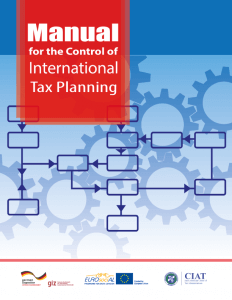Manual for the Control of International Tax Planning

"The CIAT Executive Secretariat presents the update of the Manual for the Control of International Tax Planning. This update has 42 sections, which were prepared in coordination with 55 experts who have extensive experience in tax administrations, ministries of finance, international organizations, academia, civil society and private initiatives.
The content includes an analysis of the various risks of tax evasion and avoidance, based on behaviours of multinational companies as detected by tax administrations from various countries, as well as the possible actions to identify said risks and consequently treat them. This material will be useful for all those interested in learning or strengthening their knowledge on these subjects, with a practice-based approach.
CIAT thanks all of those who generously contributed to make this initiative possible, and in particular, the GIZ (German Cooperation) and the EUROsociAL+ Program."
Manual for the Control of International Tax Planning
General Structure
-
2. International Tax Planning
-
1. Introduction, Scope, and Objective
-
4.2. Specific anti avoidance rules: domestic and international
-
5.7. Taxation of Cryptocurrencies
-
3.12. Payments for technical assistance, royalties, interests, dividends, and service fees
-
3.5. Hybrids
-
4.3. Anti-hybrid regimes
-
3.19. Tax compliance risks by companies operating in the digital economy
-
5.3. International cooperation
-
5.5. Cooperative Compliance Initiatives as a Preventative Mechanism
-
4.1. General Anti Avoidance Rules: Domestic and International
-
4.4. Ability to disregard or recharacterize transactions
-
3.9. Use of legal structures for concealment purposes, tax havens, and harmful tax regimes
-
4.8. Anti tax haven rules
-
3.10 Triangulation
-
3.2. Transfer pricing manipulation
-
5.8. Advanced Pricing Agreements (APA)
-
3.1. Thin-capitalization and other international financing operations
-
3.14. Improper contractual allocation of risk
-
3.11. Transfer of intangibles
-
3.7 Tax Residency
-
4.10. Mechanisms to prevent abuse involving transactions of commodities and raw materials
-
4.7. Transfer Pricing Regulations
-
3.3 Tax Treaty Abuse
-
3.4. Abuse of Domestic Rules
-
4.11. Measures to Contain Avoidance or Evasion by Companies Operating in the Digital Economy
-
3.18. Profit Shifting
-
5.6. Procedures to prevent abuse by companies operating in the digital economy – European and Spanish Approach
-
4.9. Measures to contain misconduct by promoters of tax planning schemes
-
3.15. Artificial fragmentation of contracts
-
3.8. Permanent establishments and commissionaire arrangements
-
3.13. Leasing Operations
-
3.17. Misuse of special purpose entities
-
3.6. Business Restructuring
-
4.12. Measures to contain the abuse of permanent establishments and commission agents
-
4.5. International Tax Transparency Standards
-
5.1. Special information regimes, development, and maintenance of databases: information obligations for taxpayers carrying out international operations.
-
3.16. Deduction of Costs, Expenses and Losses for Artificial Activities and/or Activities That Do Not Create Value
-
5.4. Initiatives regarding corporate responsibility and fiscal governance
-
4.6 Rules limiting tax base erosion through financial instruments
-
5.2 Mechanisms to identify risks
-
6.1 Audit of Multinational Enterprises and Entities with International Operations
